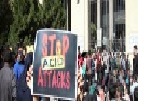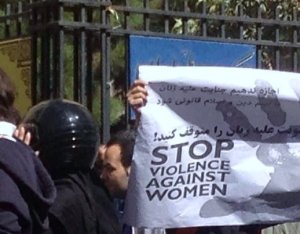Acid Attacks On Women - New Grounds for Harassing Journalists

Embarrassed by a public outcry about a spate of acid attacks on women in the central city of Isfahan since the start of October, the Iranian authorities have been threatening news media and arresting journalists and netizens.

After at least seven women had been the victims of acid attacks, scores of demonstrators gathered outside the lawcourts in Isfahan and the parliament building in Tehran on 22 October to demand an “end to violence against women.”
Several government officials and media outlets that support the Revolutionary Guards such as Tasnim and FARS have accused some media outlets of “excessive” coverage of the attacks and of “questioning the role of organizations that monitor compliance with correct women’s dress standards [Islamic Hijab].”
Most of the victims of the acid attacks are said to have been women who, in the regime’s eyes, were not “properly veiled.”
Islamic Republic prosecutor-general Ebrahim Raissi said on 27 October “we cannot close our eyes to the media crime of disturbing public opinion.” Ali Younessi, an adviser to President Hassan Rouhani, said, “an Iranian cannot have committed such a violent act” but “if the person responsible turns out to be Iranian, he must be under the influence of counter-revolutionary groups based abroad.”
Tehran’s Friday prayer leader Ahmad Khatami, an ally of Supreme Leader Ali Khamenei, said on 26 October, “media that accuse the people who monitor observance of proper social behaviour, blaming them for the acid attacks, must be prosecuted.”
Mohammad Javad Larijani, Iran’s representative at the UN Human Rights Council, referred in an interview for Iranian national TV to “the possibility of a foreign state’s support in the acid attacks affair.”
Tehran prosecutor Abbas Jafari Dowlatabadi announced on 25 October that, “as certain media reports disturbed public opinion, the editors of several newspapers have been summoned for possible prosecution.”
Plainclothes police arrested Arya Jafari, a photographer with the ISNA news agency, in Isfahan on 25 October after searching his home. Four other Isfahan-based ISNA journalists were summoned and detained on 27 October. Two of them were released provisionally a few hours later, while the editor in chief and social affairs editor were released provisionally 48 hours later. There has been no official word on the reasons for their arrests or who exactly was responsible.
On 20 October, four days after the media began covering the acid attacks, the Revolutionary Guards website in Isfahan announced the “dismantling of a malevolent organized network carrying out immoral activities on social networks” and the “arrests of six individuals with links to foreign countries.” National radio and TV broadcast their “confessions” the same evening.
According to the information obtained by Reporters Without Borders, several journalists in Tehran and Isfahan have been threatened, some of them by phone, and have been “forbidden to follow or write about this issue.”
“In the run-up to Iran’s Universal Periodic Review by the UN Human Rights Council on 31 October, we draw the council’s attention to the alarming situation of journalists in Iran,” Reza Moini, the head of the Reporters Without Borders Iran/Afghanistan desk said.
“Iran’s record on freedom of information during the past four years has been disastrous. The regime’s systematic attacks on the media and on both professional and non-professional journalists show that it has completely ignored its obligations.”
Ranked 173rd out of 180 countries in the 2014 Reporters Without Borders press freedom index, Iran is one of the world’s five biggest prisons for news providers, with a total of 48 journalists and netizens detained.